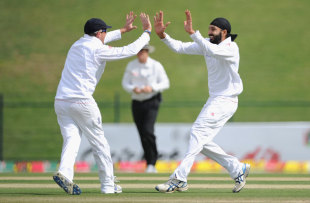A suicide note left by the nurse found dead after the hoax call to the hospital treating the Duchess of Cambridge criticised fellow staff, it emerged tonight.
The letter was one of three Jacintha Saldanha, 46, wrote before she was found
hanging in her room at a nurses’ accommodation block at the King Edward VII
Hospital in London last Friday.
Injuries to her wrists were also found, a coroner heard today. Attempts were
made to revive the nurse but they were "to no avail".
Mrs Saldanha, from Bristol, had left three suicide notes for her family and had also written emails and made telephone calls that police believe might help shed light on what happened, the court was told.
Tonight, reports claimed that one note specifically addresses her employers and criticism of hospital staff despite officials previously maintaining they were fully supportive of the nurse.
The Guardian reported that one note also specifically referred to the hoax call made by the two Australian radio presenters while a third detailed wishes for her funeral.
Two notes were found at the scene in central London and the third recovered in
the nurse’s belongings.
The mother of two’s family has been given typed copies of the three handwritten notes by the police and has read the contents, the Guardian claimed.
It has been reported that the family did not know about the hoax call until after Mrs Saldanha’s death.
Today, during a five-minute hearing at Westminster Coroner’s Court, Det Chief Insp James Harman said Mrs Saldanha, a night sister, was found by a colleague and a security guard who called the emergency services.
DCI Harman told the court: “At this time there are no suspicious circumstances apparent to me in relation to this death.”
Detectives are talking to witnesses, friends, colleagues and Mrs Saldanha’s telephone contacts, DCI Harman said, in order to establish the circumstances that may have led to, and contributed, to her death.
Referring to the two 2 Day FM presenters who made the prank call, he added: “You will be aware of the wider circumstances in this case and I can expect in the very near future we will be in contact with colleagues in New South Wales to establish the best means of putting the evidence before you.”
Coroner’s officer Lynda Martindill said Mrs Saldanha’s accountant husband Ben Barboza, 49, had identified her body. The coroner opened and adjourned the inquest, with a full hearing listed for March 26 next year.
None of Mrs Saldanha’s family attended the hearing, but one of her colleagues was there. The coroner said: “Can I express my sympathy to you and to the family.”
Mrs Saldanha was a nurse at King Edward VII hospital, West London, where the Duchess of Cambridge was being treated for severe pregnancy sickness.
During the hoax call, the nurse transferred the DJs, believing they were the Queen and Prince of Wales, to a colleague who described in detail the condition of the Duchess of Cambridge during her hospital treatment for severe pregnancy sickness.
The Australian DJs, Mel Greig and Michael Christian, have both issued emotional apologies for her death and have since been moved into “safe houses” and given 24-hour bodyguards after receiving death threats.
It emerged last night that the broadcasters responsible for airing the call are to be officially investigated by the Australian Communications and Media Authority, which regulates radio broadcasting, in line with the Commercial Radio Codes of Practice.
Her family are set to receive more than £320,000 from Southern Cross Austereo, the parent company for whom the presenters work for.
The hearing comes on the day that Southern Cross Austereo (SCA) is to resume advertising on 2 Day FM. All profits from the adverts until the end of the year will be donated to a memorial fund established in aid of her family.
Keith Vaz, the Labour MP who is helping Mr Barboza, daughter Lisha, 14, and son Junal, 16, said a memorial service would be held in Bristol tomorrow, followed by one in Westminster Cathedral on Saturday. The hospital has offered bereavement counselling for the family in Bristol, which they have decided to take up, he added.
He did not attend the hearing but said of the family: “They are grieving in their homes, they are comforting each other and the community is comforting them, that is why they have not come.” Her body was released to her family in order to arrange her funeral in India.
A hospital spokeswoman tonight said no one in senior management knew what the contents of the notes left were but she said officials “were very clear that there were no disciplinary issues in this matter”.
Both the nurses involved had been offered “full support” and “it was made clear they were victims of a cruel journalistic trick,” she added.
The mother of two’s family has been given typed copies of the three handwritten notes by the police and has read the contents, the Guardian claimed.
It has been reported that the family did not know about the hoax call until after Mrs Saldanha’s death.
Today, during a five-minute hearing at Westminster Coroner’s Court, Det Chief Insp James Harman said Mrs Saldanha, a night sister, was found by a colleague and a security guard who called the emergency services.
DCI Harman told the court: “At this time there are no suspicious circumstances apparent to me in relation to this death.”
Detectives are talking to witnesses, friends, colleagues and Mrs Saldanha’s telephone contacts, DCI Harman said, in order to establish the circumstances that may have led to, and contributed, to her death.
Referring to the two 2 Day FM presenters who made the prank call, he added: “You will be aware of the wider circumstances in this case and I can expect in the very near future we will be in contact with colleagues in New South Wales to establish the best means of putting the evidence before you.”
Coroner’s officer Lynda Martindill said Mrs Saldanha’s accountant husband Ben Barboza, 49, had identified her body. The coroner opened and adjourned the inquest, with a full hearing listed for March 26 next year.
None of Mrs Saldanha’s family attended the hearing, but one of her colleagues was there. The coroner said: “Can I express my sympathy to you and to the family.”
Mrs Saldanha was a nurse at King Edward VII hospital, West London, where the Duchess of Cambridge was being treated for severe pregnancy sickness.
During the hoax call, the nurse transferred the DJs, believing they were the Queen and Prince of Wales, to a colleague who described in detail the condition of the Duchess of Cambridge during her hospital treatment for severe pregnancy sickness.
The Australian DJs, Mel Greig and Michael Christian, have both issued emotional apologies for her death and have since been moved into “safe houses” and given 24-hour bodyguards after receiving death threats.
It emerged last night that the broadcasters responsible for airing the call are to be officially investigated by the Australian Communications and Media Authority, which regulates radio broadcasting, in line with the Commercial Radio Codes of Practice.
Her family are set to receive more than £320,000 from Southern Cross Austereo, the parent company for whom the presenters work for.
The hearing comes on the day that Southern Cross Austereo (SCA) is to resume advertising on 2 Day FM. All profits from the adverts until the end of the year will be donated to a memorial fund established in aid of her family.
Keith Vaz, the Labour MP who is helping Mr Barboza, daughter Lisha, 14, and son Junal, 16, said a memorial service would be held in Bristol tomorrow, followed by one in Westminster Cathedral on Saturday. The hospital has offered bereavement counselling for the family in Bristol, which they have decided to take up, he added.
He did not attend the hearing but said of the family: “They are grieving in their homes, they are comforting each other and the community is comforting them, that is why they have not come.” Her body was released to her family in order to arrange her funeral in India.
A hospital spokeswoman tonight said no one in senior management knew what the contents of the notes left were but she said officials “were very clear that there were no disciplinary issues in this matter”.
Both the nurses involved had been offered “full support” and “it was made clear they were victims of a cruel journalistic trick,” she added.





